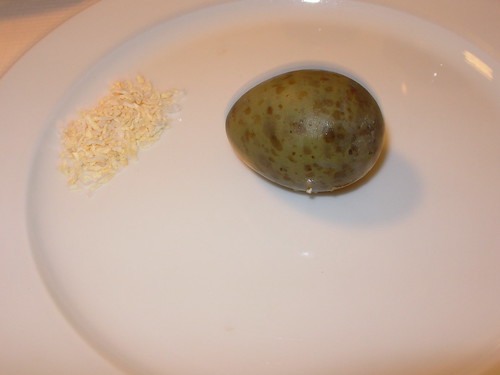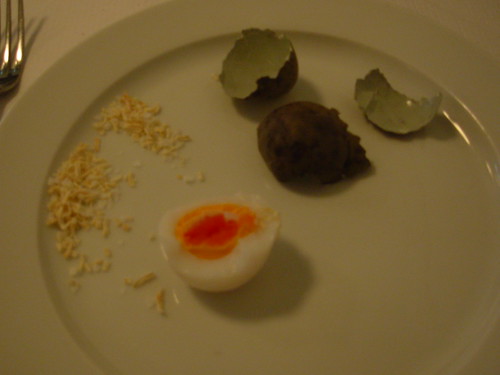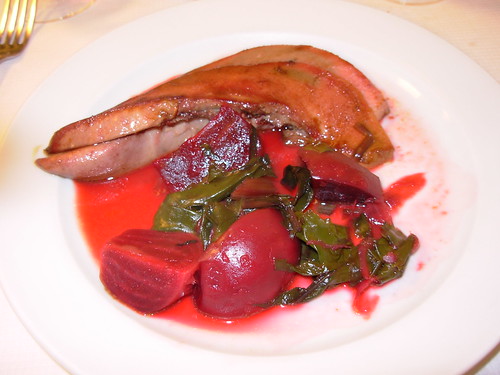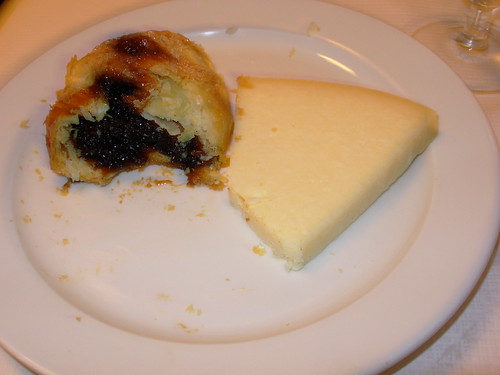There are some restaurants that change the culinary landscape: gastronomic earthquakes. Chez Penisse, Union Square Café, El Bulli and The American Place are some that come to mind. St. John, set near London’s Smithfield Market, is another. Chef Fergus Henderson believes in using the animal from head to end, as he describes in his respected 2004 cookbook The Whole Beast: Nose to Tail Eating. Chef Henderson is fighting a wasting ailment, and will probably never stand behind a stove, but his influence is profound.
St. John eschews the fancy for the solid, the dramatic for the solid. While this style of cuisine has been termed Haute Barnyard, I think of it as Haute Slaughterhouse. It is less the product of the farm than of the butcher. The menu my evening included salted pig’s liver, kid, and chitterlings, but also such rarely served seafood as brill, and pollock. The dining room is ostentatiously simple, more like a nineteenth century workers’ mess, along the lines of Peter Luger. And prices are modest by London standards (my four courses were about 40 pounds).
My starter was a single gull’s egg with celery salt. I had some idea that this might be an egg of special flavor, but, despite a spotted shell and startling orange yolk, eaten blindfold this would have the taste much like any hardboiled egg.


The appetizer, a signature dish for Chef Henderson was Roasted Bone Marrow – four rough cut bones – with their marrow intact, served with Grilled Toast, Sea Salt, and Parsley Salad with Capers and Onions. This was carnally sublime and the recognition that marrow is moral deservedly helped to catapult St. Johns into the influential establishment that it is. St. John’s food is neither complex or fussy, what makes this work so well is that Henderson takes what has not be considered to be restaurant food, and prove its delights. The addition of the parsley salad matched the marrow, both in its lushness and in that it overturns the belief that parsley is not a suitable focus for high end dining. A remarkable appetizer.

I chose Veal’s Tongue with Beetroot as my main course. The plate was almost audacious in its simplicity. I was presented with two pieces of veal tongue, baked and fried, and some plain beets. Yet, the modesty of the tongue, a most remarkably tender cut with the slightest taste of cured beef tongue, proved that this is no parlor trick. The beet matched the tongue without being elaborated in any way.

As dessert I selected St. John’s treatment of an Eccles Cake, served with a slice of Lancaster cheese. The cheese was perfectly vibrant, but the Eccles cake, filled with a think and dense layer of raisins, was more of a pastry than a dessert, strictly speaking, and might have been more appealing had it been served warm with a scoop of, say, rum raisin ice cream.

St. Johns plainspeak is distant from the elegance of Gordon Ramsay where I ate lunch, and yet it is perhaps a measure of the influence of the former on the latter than my lunch included pied au cochon and duck gizzard. While we have not seen a large influence of haute slaughterhouse cuisine on the American shores – and it may take awhile to penetrate, given Yankee squeamishness towards offal – in time we will be consuming veal tongue, unless moral politics intervenes.
St. John
26 St. John Street
London (Smithfield Market)
020-7251-0848
www.stjohnrestaurant.com

No comments:
Post a Comment